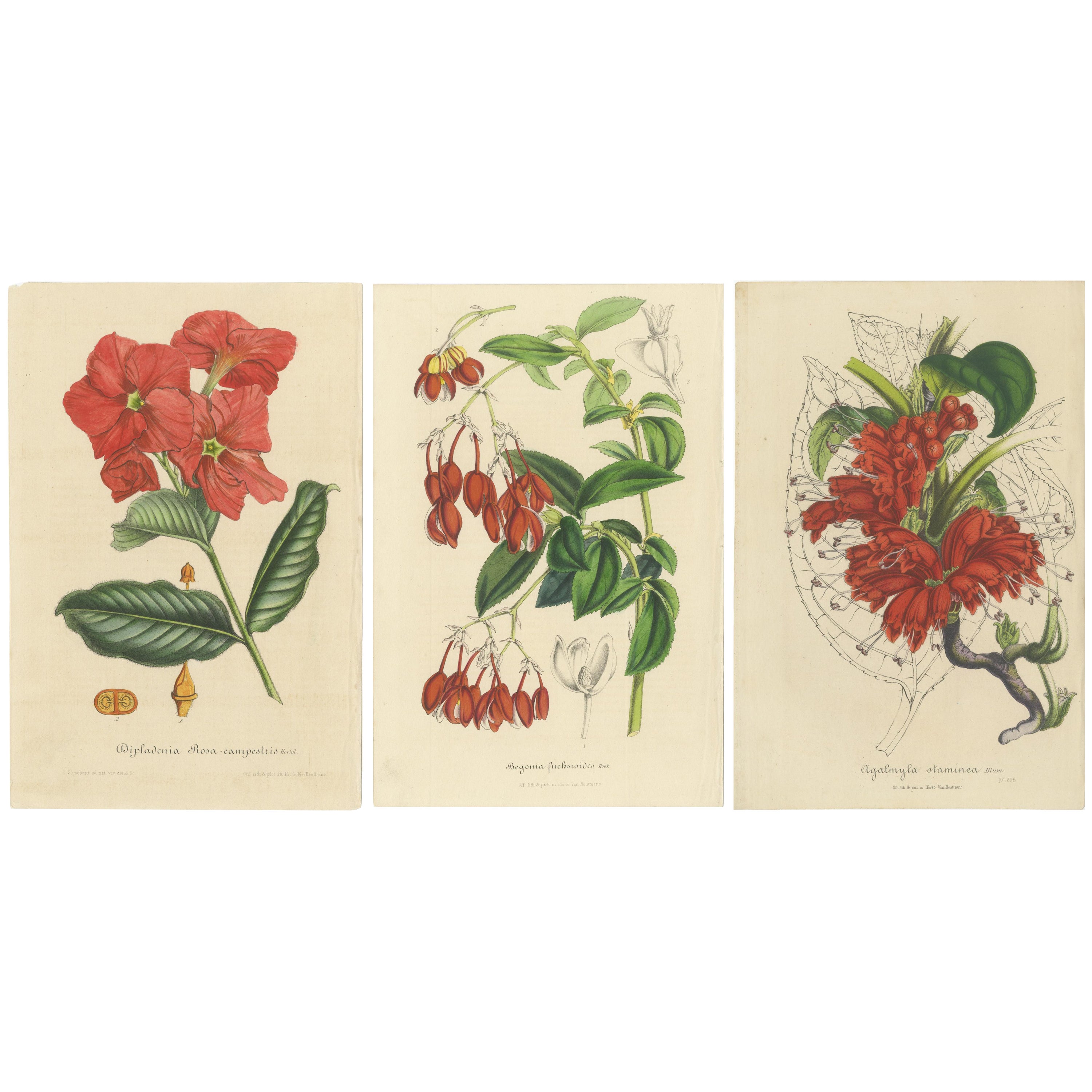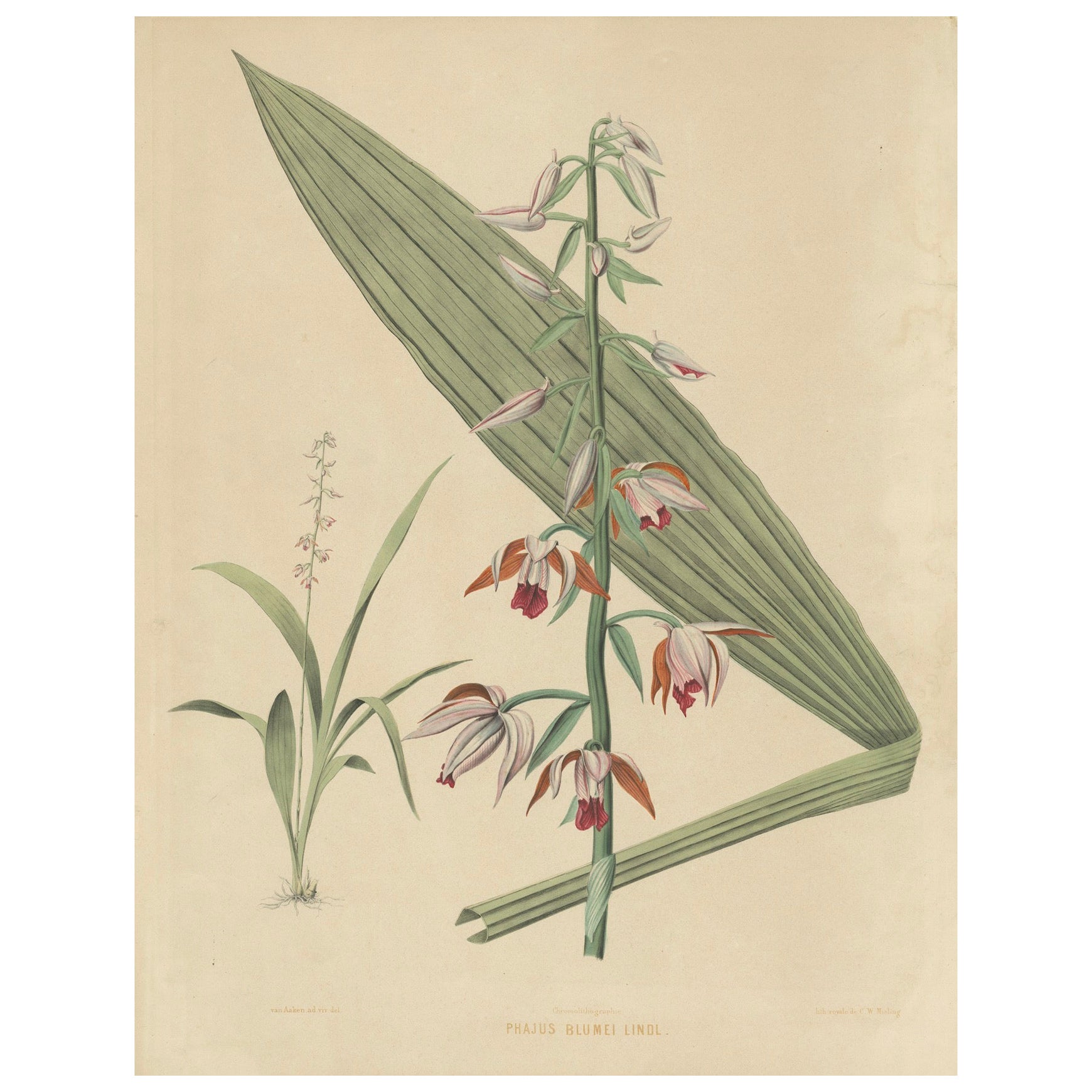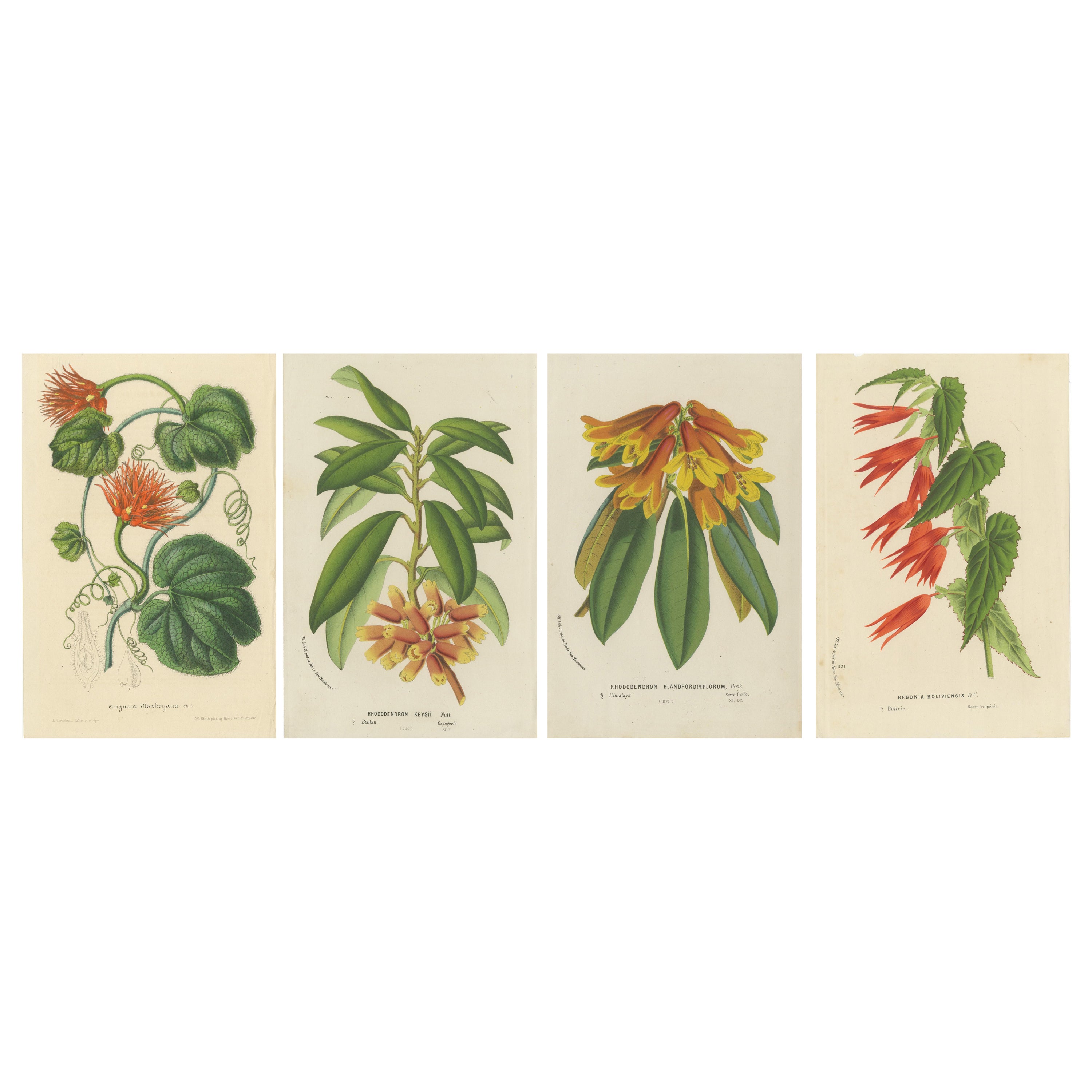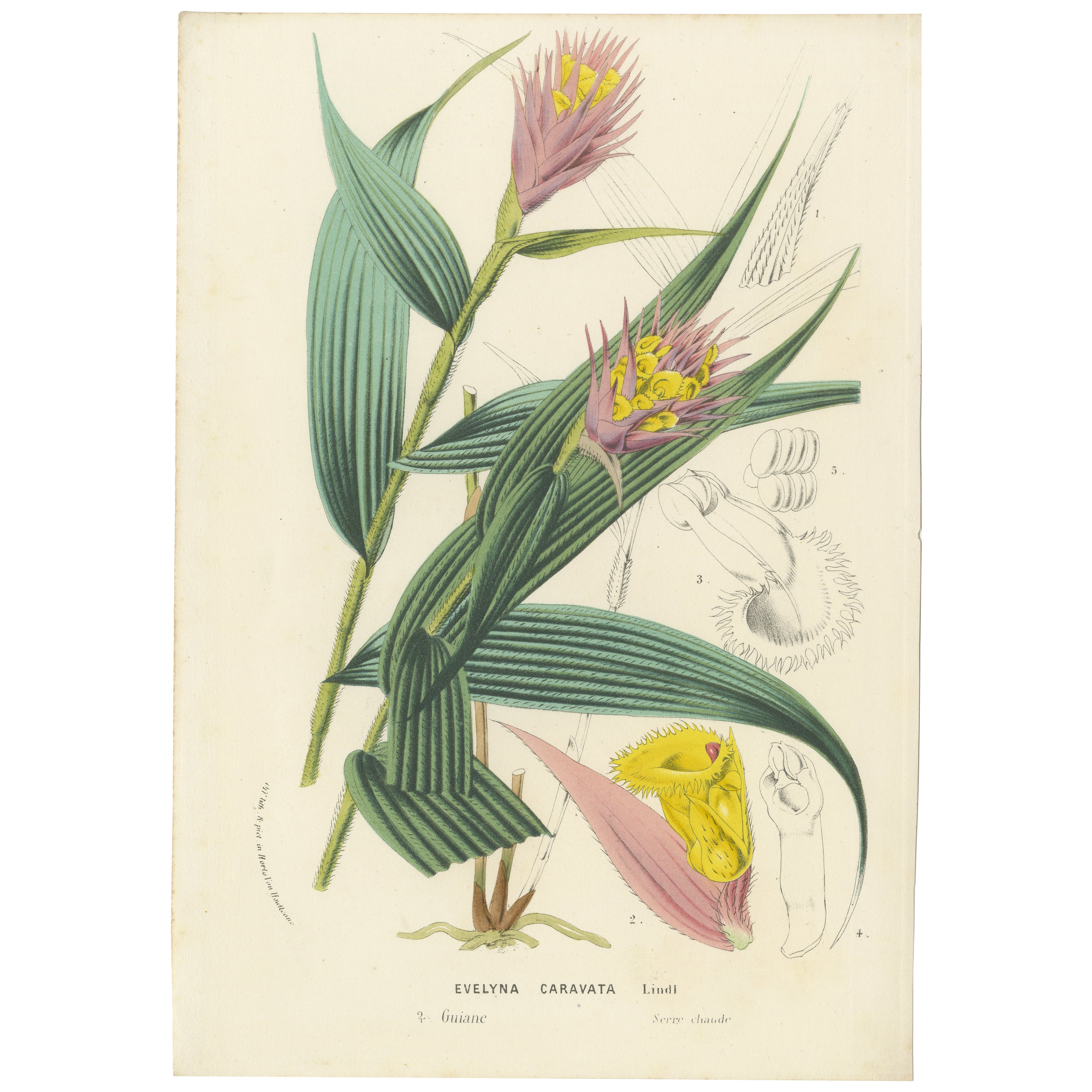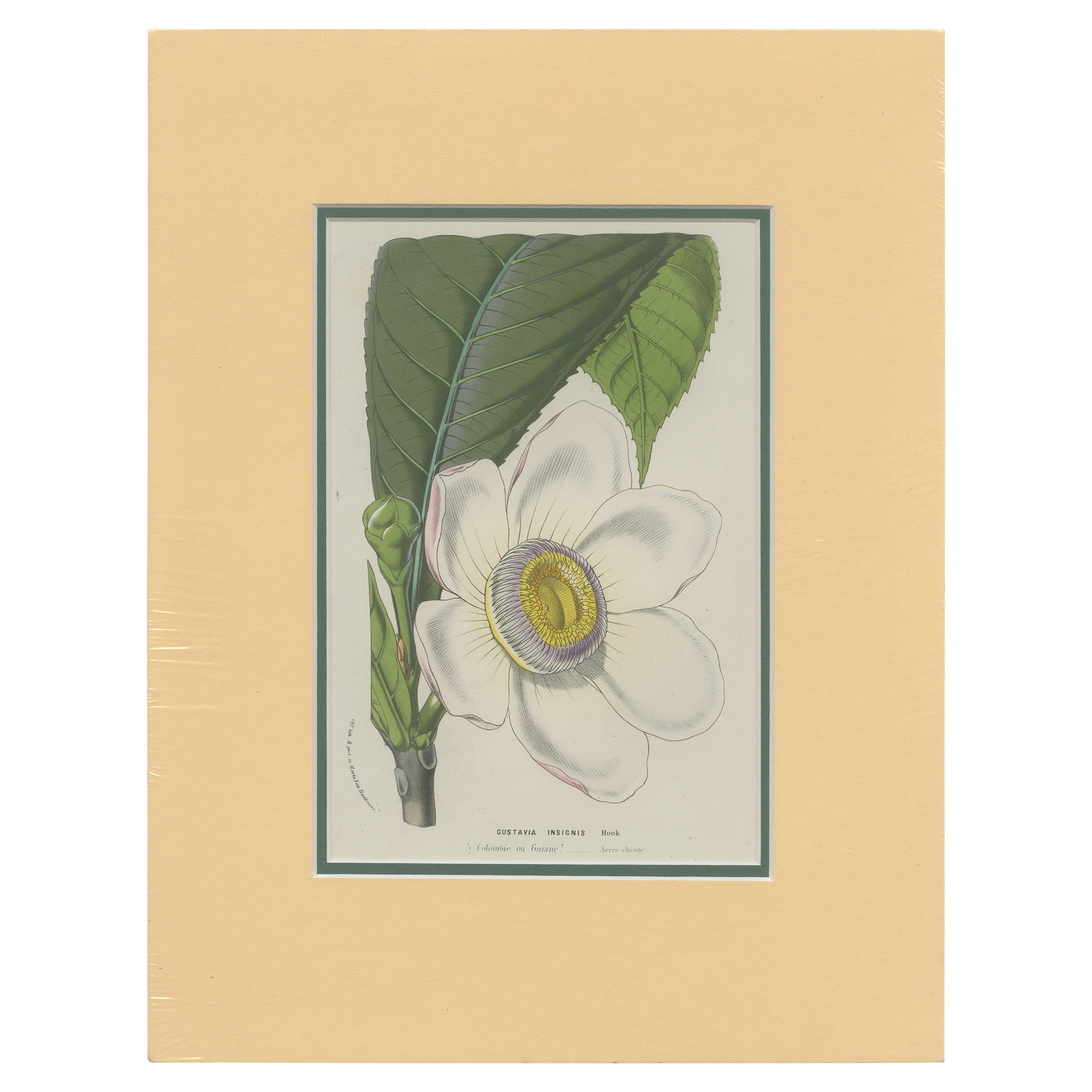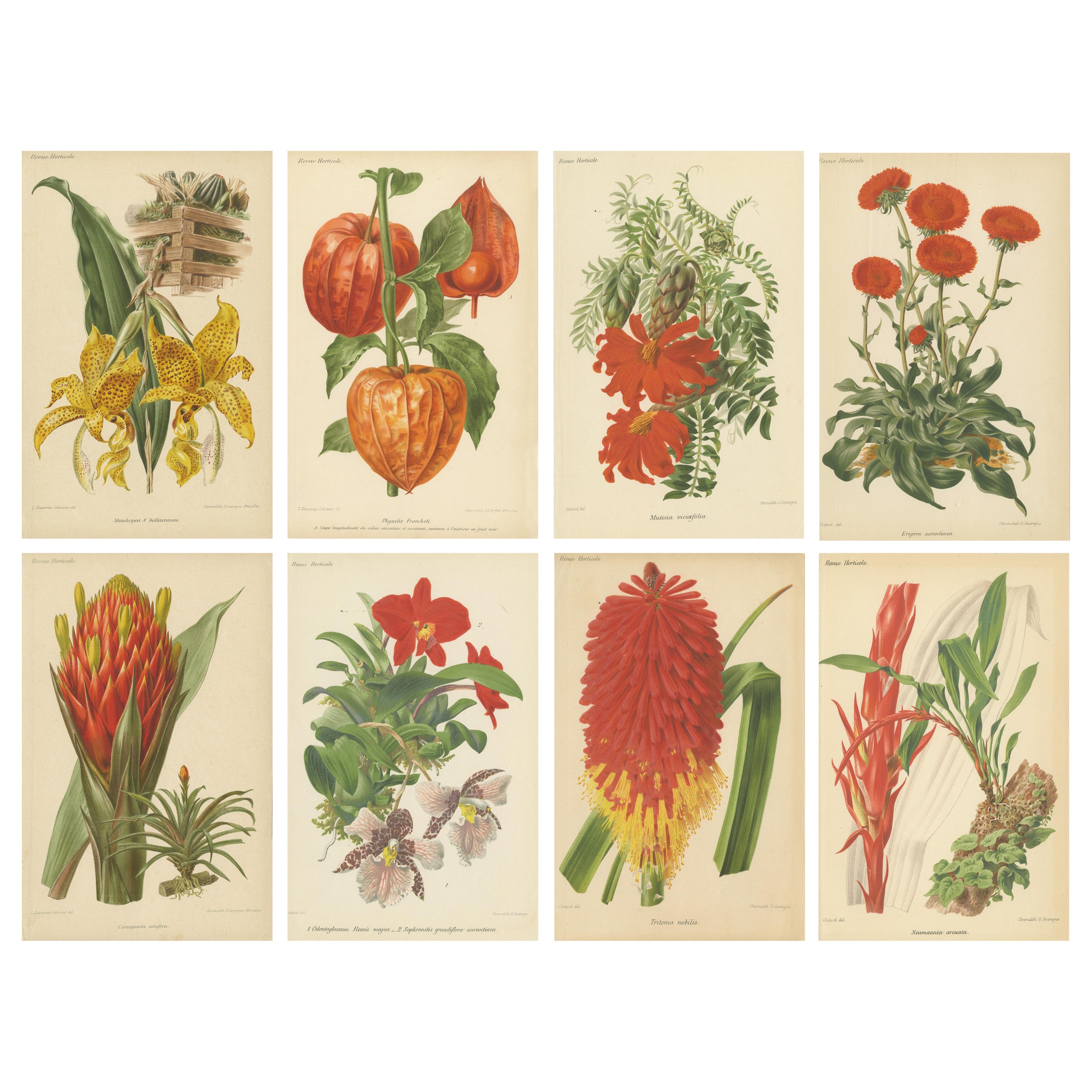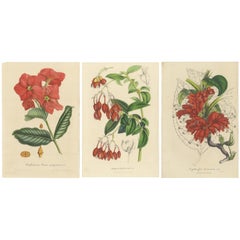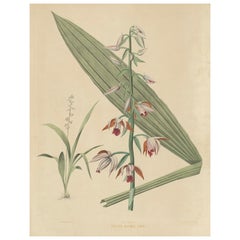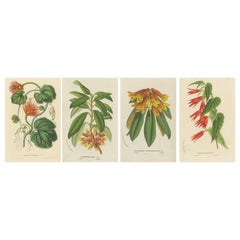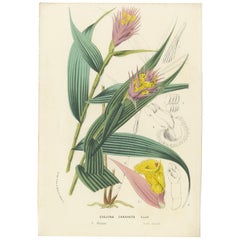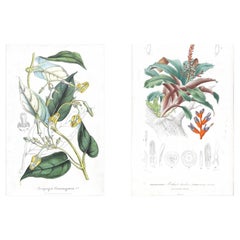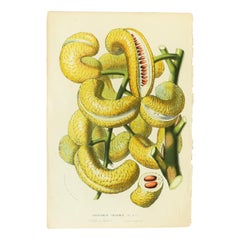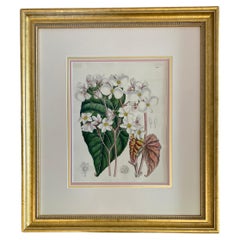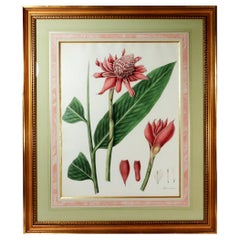Items Similar to A Rare Botanical Study of Exotic Flora by Hoola van Houten, 1847
Want more images or videos?
Request additional images or videos from the seller
1 of 5
A Rare Botanical Study of Exotic Flora by Hoola van Houten, 1847
$168.14
£123.83
€140
CA$228.74
A$254.18
CHF 133.19
MX$3,117.05
NOK 1,698.79
SEK 1,598.16
DKK 1,065.80
Shipping
Retrieving quote...The 1stDibs Promise:
Authenticity Guarantee,
Money-Back Guarantee,
24-Hour Cancellation
About the Item
A Rare Botanical Study of Exotic Flora by Hoola van Houten*
This beautifully hand-colored botanical illustration by Hoola van Houten features an exotic flowering plant, carefully detailed with delicate bell-shaped blooms and lush green leaves. The intricate red and yellow patterns on the flowers, along with precise sketches of the plant's reproductive parts on the side, reflect the artist's scientific accuracy and artistic skill.
The print is elegantly mounted in a soft yellow matting board, which complements the warm tones of the flowers and enhances the visual impact of the illustration.
Hoola van Houten, active in the 19th century, was known for his contributions to botanical art, capturing the beauty and complexity of tropical plants brought to Europe during the age of exploration. This piece exemplifies the Golden Age of botanical illustration, blending scientific knowledge with fine artistry.
The plant’s detailed depiction suggests it may be part of the *Ericaceae* family, a group known for its bell-shaped flowers and evergreen foliage. This illustration not only serves as a historical record of botanical discovery but also stands as a work of timeless beauty, ideal for collectors or display.
Its condition is excellent, with vibrant colors, clean paper, and no visible damage, making it a remarkable example of 19th-century botanical art.
- Dimensions:Height: 13.59 in (34.5 cm)Width: 9.45 in (24 cm)Depth: 0.12 in (3 mm)
- Materials and Techniques:
- Period:
- Date of Manufacture:1847
- Condition:The print is in very good condition with vibrant colors, clean paper, and no visible damage such as stains, foxing, or tears. Intact margins and careful matting enhance its presentation, making it well-preserved and ideal for display.
- Seller Location:Langweer, NL
- Reference Number:Seller: BG-000291stDibs: LU3054342820232
About the Seller
5.0
Recognized Seller
These prestigious sellers are industry leaders and represent the highest echelon for item quality and design.
Platinum Seller
Premium sellers with a 4.7+ rating and 24-hour response times
Established in 2009
1stDibs seller since 2017
2,494 sales on 1stDibs
Typical response time: 1 hour
- ShippingRetrieving quote...Shipping from: Langweer, Netherlands
- Return Policy
Authenticity Guarantee
In the unlikely event there’s an issue with an item’s authenticity, contact us within 1 year for a full refund. DetailsMoney-Back Guarantee
If your item is not as described, is damaged in transit, or does not arrive, contact us within 7 days for a full refund. Details24-Hour Cancellation
You have a 24-hour grace period in which to reconsider your purchase, with no questions asked.Vetted Professional Sellers
Our world-class sellers must adhere to strict standards for service and quality, maintaining the integrity of our listings.Price-Match Guarantee
If you find that a seller listed the same item for a lower price elsewhere, we’ll match it.Trusted Global Delivery
Our best-in-class carrier network provides specialized shipping options worldwide, including custom delivery.More From This Seller
View AllExquisite Botanical Illustrations from Curtis’s Botanical Magazine (1847)
Located in Langweer, NL
These beautiful hand-colored botanical illustrations, drawn and lithographed by the renowned artist Walter Hood Fitch, were featured in Sir William Jackson Hooker's *"Curtis's Botanical Magazine,"* published in London in 1847. Fitch was one of the most prolific and skilled botanical illustrators of the 19th century, known for his ability to capture the intricate details and vibrant hues of the plants he depicted.
Sir William Jackson Hooker, a famous British botanist and the director of the Royal Botanic Gardens, Kew, commissioned these illustrations as part of his work to document newly discovered plants from around the world. The *Curtis’s Botanical Magazine* has been published since 1787 and remains one of the longest-running botanical periodicals.
Detailed Descriptions of Each Plant
#### 1. **Dipladenia Rosa-campestris** (*Hortul. ex Veitch*)
- **English Name**: Rose Dipladenia
- **Description**: This illustration showcases *Dipladenia rosa-campestris*, a striking flowering plant known for its showy pink to deep red trumpet-shaped flowers. Native to tropical regions of South America, particularly Brazil, *Dipladenia* belongs to the family Apocynaceae and is prized in horticulture for its vibrant blooms and ability to climb. Fitch's illustration emphasizes the waxy leaves and the vivid color of the petals, bringing the plant to life on the page.
#### 2. **Begonia fuchsioides** (*Hook.*)
- **English Name**: Fuchsia-flowered Begonia
- **Description**: The *Begonia fuchsioides* is depicted with its characteristic red, pendulous flowers, which closely resemble the blooms of fuchsia plants. This species of Begonia is native to tropical regions and is popular for its delicate, bell-shaped flowers and glossy leaves. Fitch’s attention to the arrangement of the leaves and the contrast between the flowers' vibrant red and the soft green leaves provides a lifelike representation of this exotic plant.
#### 3. **Agalmyla staminea** (*Blume*)
- **English Name**: Staminate Agalmyla
- **Description**: This illustration captures the unique red tubular flowers of *Agalmyla staminea*, a plant native to Southeast Asia. The species is part of the Gesneriaceae family and is known for its bright, showy flowers that grow in dense clusters. Fitch’s careful rendering of the plant’s leaves and the intricate veining, along with the vibrant red flowers, highlights his talent for bringing the botanical subject to life with both scientific accuracy and artistic flair.
### About the Makers
#### **Walter Hood Fitch** (Artist and Lithographer)
Walter Hood Fitch (1817–1892) was one of the most influential botanical artists of the 19th century, working primarily with Sir William Hooker and later his son, Joseph Dalton Hooker, at Kew Gardens. He produced thousands of illustrations for various botanical publications, including *Curtis’s Botanical Magazine*, where he was responsible for the majority of its plates from 1834 to 1877. Fitch’s mastery of lithography allowed him to create richly detailed and accurate depictions of plants, with a particular talent for illustrating both the botanical structure and the vibrant colors of flowers.
#### **Sir William Jackson Hooker** (Director and Editor)
Sir William Jackson Hooker (1785–1865) was a prominent British botanist and the director of the Royal Botanic Gardens, Kew. Under his leadership, Kew Gardens expanded its collection of plants from around the world, and Hooker was instrumental in promoting the scientific study and illustration of these species. As the editor of *Curtis’s Botanical Magazine*, Hooker collaborated with Fitch to document and share the beauty and diversity of plants with the scientific community and the public.
### The Lithographic Technique
Lithography, particularly chromolithography, was a crucial innovation in botanical illustration. Fitch was skilled in the traditional method of lithography, where an image was drawn onto a stone plate with a greasy substance and then inked for printing. Hand-coloring was often applied afterward to bring the prints to life, as seen in these illustrations. This method allowed for highly detailed, accurate representations of plants and their botanical features, making it invaluable for both scientific study and aesthetic appreciation.
### Conclusion
These prints from *Curtis’s Botanical Magazine* reflect the height of botanical art in the mid-19th century. The combination of Walter Fitch...
Category
Antique 1840s Prints
Materials
Paper
$413 Sale Price / set
20% Off
Large Masterpiece of Botanical Illustration from the Dutch East Indies, 1854
Located in Langweer, NL
A large chromolithograph botanical illustration, featuring the orchid species Phaius blumei Lindl. The print comes from the 19th-century work "Illustrations d'orchidees des Indes Ori...
Category
Antique 1850s Prints
Materials
Paper
$1,345 Sale Price
20% Off
Free Shipping
Lush and Vibrant: A Collection of Exotic Botanical Illustrations, circa 1875
Located in Langweer, NL
The prints depict a selection of exotic plants with a remarkable detail and vibrant color, showcasing the beauty and diversity of botanical life. Each illustration is a testament to ...
Category
Antique 1870s Prints
Materials
Paper
$393 Sale Price / set
20% Off
Caravata Plant Botanical Illustration by Louis van Houtte, 19th Century
Located in Langweer, NL
Caravata Plant Botanical Illustration by Louis van Houtte, 19th Century
This botanical illustration features Evelyna caravata, commonly known as the Caravata Plant, notable for its ...
Category
Antique 1850s Prints
Materials
Paper
$134 Sale Price
20% Off
Antique Botany Print of the Gustavia Insignis by Van Houtte 'c.1845'
Located in Langweer, NL
Antique botany print titled 'Gustavia Insignis'. Original antique print of the Gustavia Insignis. This print originates from 'Flore des Serres' by Louis van Houtte...
Category
Antique Mid-19th Century Prints
Materials
Paper
$96 Sale Price
20% Off
Original Vintage Botanical Illustrations from Revue Horticole, circa 1855
Located in Langweer, NL
Here are descriptions of the eight botanical illustrations, including the Latin and English names of the plants, why they are significant, and details about the creators and the tech...
Category
Antique 1850s Prints
Materials
Paper
$643 Sale Price / set
20% Off
You May Also Like
Set of Two Rare Botanical Engravings by D’Orbigny — 1849
Located in Fukuoka, JP
Set of Two Rare Botanical Engravings by D’Orbigny — Dictionnaire Universel d’Histoire Naturelle, Paris, 1849
An exquisite pair of original hand-colored botanical engravings from the...
Category
Antique 19th Century French Prints
Materials
Paper
European Exotic Fruit Botanical Wall Art Litho, circa 19th Century
Located in New York, NY
A very beautiful original Belgian exotic botanical vibrant off-set lithograph, 'Decaisnea Insignis', by artis Horto Van Houtteano, circa 19th century, Belgium. 'Decaisnea Insignis' i...
Category
Antique Late 19th Century Belgian Prints
Materials
Paper
John Nugent Fitch Orchids, 19th Century Hand Colored Engraving Botanical Print
By John Nugent Fitch
Located in Miami, FL
This beautiful, original hand-colored orchid lithograph of "Begonia Scharffii" Orchids by John Nugent Fitch is plate number 7028 from Robert Warner's publication 'The Orchid Album, C...
Category
Antique Mid-19th Century British Victorian Prints
Materials
Wood, Paper
William Roscoe Large Botanical Print of Tropical Plant
Located in Downingtown, PA
William Roscoe Botanical Tropical Plant Print,
Alpinia Magnifica,
Monandrian Plant of the Order Scitamineae,
Published 1828
A spectacularly large and beautifully framed botanical pr...
Category
Antique 1820s English Regency Prints
Materials
Paper
William Roscoe Botanical Large Print of Tropical Plant, Zingiber Capitatum
Located in Downingtown, PA
William Roscoe Botanical Large Print,
Zingiber Capitatum,
Monandrian Plants of the Order Scitamineae,
1828
A spectacularly large and beautifully framed botanical print. The subjects...
Category
Antique Early 19th Century English Regency Prints
Materials
Paper
Bignonia venusta – Antique Botanical Chromolithograph, 1880s
Located in Fukuoka, JP
A striking original botanical print from the 1880s, featuring Bignonia venusta, also known as flame vine or orange trumpet vine. This brilliantly colored illustration captures the dr...
Category
Antique 19th Century French Prints
Materials
Paper
More Ways To Browse
Hand Colored Botanical
Antique Punched Tin
Antique Soapstone Carvings
Antique Spice Jar
Antique Spice Jars
Antique Spindle Shelf
Antique Teddy Bears
Antique Teller
Antique Tiger Maple Furniture
Antique Tobacco Barrel
Antique Wine Chest
Art Deco Cloud Chairs
Art Deco Dancer Egypt
Art Deco Polo
Art Nouveau Card Tray
Art Nouveau Scarf
Asian Black Lacquer Mirror
Asian Chinoiserie Rosewood
